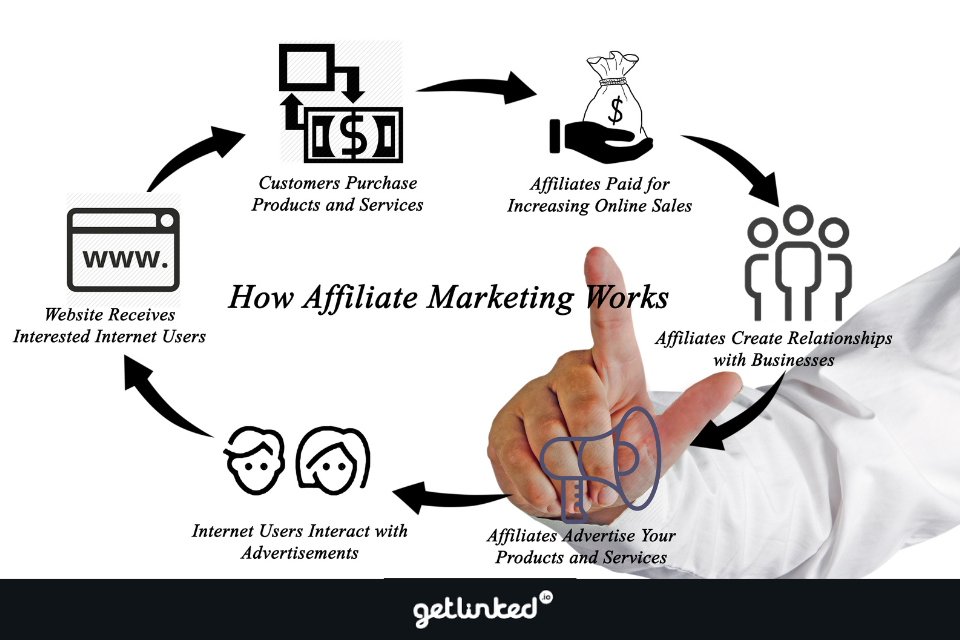Be An Affiliate Marketer Selling Other People’s Products
Affiliate marketing is a type of marketing where you promote other people’s products and earn a commission when someone buys the product through your referral link.
This can be a great way to earn a passive income and work from home.
In this blog, we will discuss how to be an affiliate marketing selling other people’s products, the types of affiliate marketing, how affiliate marketers are paid, common types of affiliate marketing channels, and tips for becoming a successful affiliate marketer.
Why Consider Affiliate Marketing?
Affiliate marketing is a low-risk and low-cost business model. You don’t have to invest any money upfront, and you can start promoting products right away. You also don’t have to worry about inventory, shipping, or customer support. All you have to do is promote the product, and the merchant takes care of the rest.
Affiliate marketing also allows you to earn a passive income. Once you have set up your affiliate marketing campaigns, you can earn money even while you sleep. You don’t have to be physically present to make sales, and you can earn money from anywhere in the world.
How Does Affiliate Marketing Work?
Affiliate marketing works by promoting other people’s products through a unique referral link. When someone clicks on your referral link and makes a purchase, you earn a commission. The commission rate varies depending on the product and the merchant.
To get started with affiliate marketing programs, you need to find a product or service that you want to promote. You can do this by joining an affiliate network or by contacting individual merchants directly. Once you have found a product, you need to sign up for their affiliate program and get your unique referral link. You can then promote the product through your website, social media, or other marketing channels.

Types of Affiliate Marketing
There are different types of affiliate marketing, including pay-per-click (PPC), pay-per-sale (PPS), and pay-per-lead (PPL).
PPC affiliate marketing involves earning a commission every time someone clicks on your referral link. PPS affiliate marketing involves earning a commission when someone makes a purchase through your referral link. PPL affiliate marketing involves earning a commission when someone signs up for a trial, fills out a form, or takes some other action.
How Affiliate Marketers are Paid
Affiliate marketers are typically paid on a commission basis. The commission rate varies depending on the product and the merchant. Some merchants may pay a fixed commission rate, while others may pay a percentage. Additional payment models include:
Cost Per Acquisition (CPA)
This is one of the most common payment models for affiliate marketing.
In this model, the affiliate is paid a commission for every sale or conversion they generate for the advertiser. The commission amount is usually a percentage of the sales price or a flat fee.
For example, if an affiliate promotes a product that sells for $100 and the commission rate is 10%, the affiliate would earn $10 for every sale they generate.
CPA is popular because it aligns the incentives of both the advertiser and the affiliate, as the advertiser only pays for actual sales or conversions.
Cost Per Click (CPC)
In this model, the affiliate is paid for every click on their affiliate link that leads to the advertiser’s website, regardless of whether a sale is made or not. CPC can be an attractive option for affiliates because they don’t have to worry about whether the visitor ultimately converts into a sale or not.
However, advertisers may be less likely to use CPC because they may end up paying for clicks that don’t result in any sales.
Cost Per Lead (CPL)
This model involves the affiliate being paid a commission for every lead they generate for the advertiser. A lead could be a sign-up for a newsletter, a trial offer, or a free sample.
CPL is a useful payment model for advertisers who are looking to generate leads for their business, as it allows them to pay only for leads that are potentially interested in their promoted products or services.
Revenue Sharing
This model involves the affiliate receiving a percentage of the revenue generated by the advertiser’s website from the customers referred by the affiliate. This can be an attractive option for affiliates because they have the potential to earn ongoing income from the customers they refer.
Revenue sharing is commonly used in industries such as web hosting, where customers typically pay a recurring fee.

Common Types of Affiliate Marketing Channels
There are several channels through which affiliate marketers can promote products, including:
Blogging
Affiliate marketing through blogging involves creating content around products or services and including affiliate links within that content. For example, a food blogger might write a recipe post that includes links to products like cookware or ingredients that they use and recommend.
Social Media
Social media platforms like Instagram, Twitter, and Facebook are popular for affiliate marketing because they allow affiliates to reach a large audience quickly. Affiliates can use these platforms to promote products by creating posts, stories, or other content that includes affiliate links.
Email Marketing
Affiliates can promote products through email marketing campaigns by sending emails to their list of subscribers. These emails can include product recommendations and affiliate links. To be successful with email marketing, affiliates need to have a high-quality email list and create compelling content that encourages clicks and conversions.
Podcasting
Podcasts have become a popular medium for affiliate marketing because they provide a unique opportunity for affiliates to connect with their audience in a more intimate way. Affiliates can promote products on their podcasts by integrating sponsored segments or mentioning products and services during their episodes.
For example, a health and wellness podcast might have a segment where the host promotes a supplement or other health product and includes an affiliate link for listeners to purchase the product.
Influencer Marketing
Influencer marketing is a form of affiliate marketing where influencers with large followings on social media or other platforms promote products to their audience. Influencers may receive a flat fee or a commission based on sales generated through their affiliate links.
For example, a fitness influencer on Instagram might promote a new line of workout clothes and include an affiliate link for followers to purchase the clothes.
Paid Advertising
Affiliates can use paid advertising channels like Google Ads, Facebook Ads, or Instagram Ads to drive traffic to affiliate products. They create ads that promote products and include their affiliate links, and then pay to have those ads displayed to their target audience.
|
Example Let’s say that an affiliate marketer is promoting a line of fitness products, such as workout clothing, equipment, and supplements. They create an ad that showcases the benefits of the products and includes their unique affiliate link. They then set up a Google Ads campaign targeting people who are interested in fitness and health. The affiliate marketer pays Google to display their ad to this specific audience, and when someone clicks on the ad and makes a purchase using the affiliate link, the affiliate earns a commission on the sale. Similarly, the affiliate could also create ads on Facebook or Instagram targeting users who have shown an interest in fitness or follow fitness-related pages. By using paid advertising channels, affiliates can reach a larger audience and increase their chances of earning commissions on sales. |
YouTube
YouTube is a popular platform for affiliate marketers because it allows them to create video content that can showcase products in a more engaging and dynamic way than other channels.
Affiliates can create product reviews or other types of content that promotes products to their audience, and they can include their affiliate links in the video description or within the video itself. For example, a technology reviewer might create a video that reviews a new laptop and includes affiliate links to purchase the laptop from an online retailer
Comparison and Review Websites
Websites that compare and review can be valuable for consumers who are looking to make informed purchasing decisions. Affiliates can earn commissions by including affiliate links in their content that directs users to purchase the products or services they are reviewing.
For example, a website that compares travel insurance options might include affiliate links to purchase the recommended travel insurance policies.
7 Tips For Becoming a Successful Affiliate Marketer
Affiliate marketing is a competitive industry with 1 in 6 affiliates earning roughly $50,000 per year and with 4% earning over $150,000. Given the high competition, it’s essential for new affiliate marketers to be as resourceful as possible. To maximize your chance of success, deploy the following 7 steps:
1. Choose the Right Products
To be successful in affiliate marketing, you need to promote products that are relevant to your target audience. Consider the demographics and interests of your audience when selecting products to promote. It’s also important to promote products that you have personally used or believe in. This will make your recommendations more authentic and trustworthy.
2. Build Trust with Your Audience
Your audience needs to trust you to take your recommendations seriously. Be honest about your affiliate marketing efforts and disclose when you are using affiliate links. Promote products that align with your values and that you genuinely believe will benefit your audience.
3. Create High-Quality Content
Your content needs to be high-quality and provide value to your audience. This will help you build a loyal following and establish yourself as an authority in your niche. Consider creating a mix of different types of content, such as:
- Videos
- A blog post
- Email marketing
- Social media content
This will help you reach a wider audience and keep your content fresh and engaging.
4. Utilize Multiple Marketing Channels
To reach a larger audience, use a variety of marketing channels. Social media platforms like Instagram, Facebook, and Twitter can be great for promoting an affiliate product. Email marketing is another effective way to reach your audience and promote products. Paid advertising can also be effective, but it’s important to carefully track your ROI to ensure that you are earning a profit.
5. Test & Track Campaigns
To maximize your earnings potential, it’s important to test and track your campaigns. Use analytics tools to monitor your performance and identify areas for improvement. Consider testing different types of content, marketing channels, and products to see what works best for your audience.
6. Staying Relevant to Industry Trends
The world of affiliate marketing is constantly evolving, and it’s important to stay informed about the latest trends and changes in the industry. This includes staying up-to-date on new marketing channels, changes to search engine algorithms, and emerging technologies that could impact your affiliate marketing efforts.
By staying informed about industry trends, you can adapt your strategies accordingly and stay ahead of the competition. Some ways to stay up-to-date include following industry publications, attending conferences and webinars, and networking with other affiliate marketers.
7. Join Affiliate Programs with High Commission Rates
Commission rates can vary widely among affiliate programs, so it’s important to do your research and join programs with high commission rates.
Look for programs that offer commissions of at least 20-30% or higher, and consider the potential for recurring commissions or bonuses.
However, it’s also important to consider factors beyond just commission rates, such as the quality of the products or services being offered, the reputation of the company, and the level of support and resources provided to affiliates.
Some ways to find high-paying affiliate programs include:
- Searching affiliate networks
- Reaching out to companies directly
- Networking with other affiliate marketers to learn about their top-performing programs
Ultimately, the key is to find programs that align with your audience and offer the potential for strong earnings.
Why Be An Affiliate Marketer Selling Other People’s Products?
There are several reasons why someone might choose to become an affiliate marketer and sell other people’s products. These include:
- Low Start-Up Costs – Affiliate marketing is a low-cost business model, as you don’t need to create your own products or maintain inventory. You can get started with minimal investment and earn commissions on sales without the overhead costs associated with running a traditional business.
- Flexibility – Being an affiliate offers flexibility in terms of where and when you work. You can work from anywhere with an internet connection, and you can set your own schedule based on your personal preferences and lifestyle.
- Passive Income Potential – Affiliate marketing allows you to earn passive income by promoting products that are already in demand. Once you have created quality content promoting a product with your unique affiliate link, you can continue to earn commissions on any sales made through that link.
- Diverse Product & Service Options – As an affiliate marketer, you have access to a wide range of products and services to promote. This allows you to find products that align with your audience’s interests and needs, and to diversify your income streams by promoting multiple products.
- No Customer Service or Support – As an affiliate marketer, you don’t need to worry about providing customer service or support for the products you promote. That responsibility falls on the product owner or merchant, leaving you free to focus on promoting the products and earning commissions.
Overall, affiliate marketing can be a lucrative and rewarding business model for those looking to earn income online without the overhead costs and responsibilities of creating and maintaining their own products.
|
For more relevant information, visit our following related blogs:
|
Cover Your Affiliate Marketing Needs Today With Getlinked
Affiliate marketing offers a wealth of opportunities for individuals looking to earn income online. With low start-up costs, flexibility, and the potential for passive income, it’s no wonder why so many people are turning to affiliate marketing as a way to build their own businesses.
And when it comes to finding the best performance marketing platform for your affiliate marketing needs, look no further than Getlinked. As a trusted platform with a proven track record of success, Getlinked offers a range of features and tools to help you succeed as an affiliate marketer. From a user-friendly interface and in-depth analytics to dedicated support and a wide range of high-paying affiliate programs, Getlinked has everything you need to build a profitable affiliate marketing business.
So if you’re ready to take your affiliate marketing efforts to the next level, consider joining the Getlinked community today. With the right tools and support, you can achieve your financial goals and build a successful online business as an affiliate marketer.

